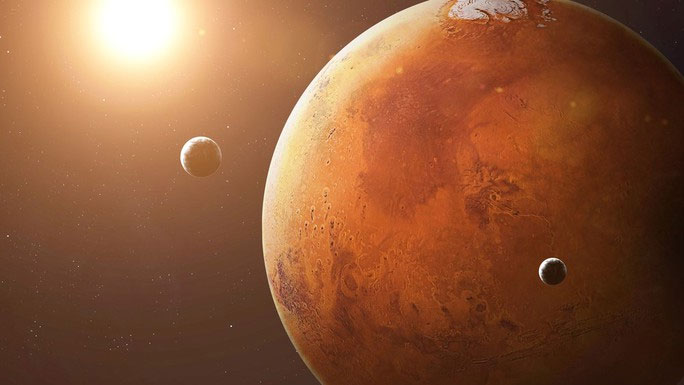A new study has revealed chilling evidence that Phobos, one of the unluckiest moons in the Solar System, is nearing its end.
Not as dazzling as Earth’s moon, Mars’ moon Phobos is quite small and has an odd shape, often compared to… a potato. Now, a recently published study in The Planetary Science Journal indicates that this “potato” is also on the verge of becoming a thing of the past.

Mars and its Moons – (Image: NASA/LIVE SCIENCE)
Utilizing data recorded by NASA’s orbiters, a team of authors from the School of Aerospace Engineering at Tsinghua University, the School of Aerospace Science and Engineering at Beihang University in Beijing, China, and the Lunar and Planetary Laboratory at the University of Arizona in Tucson, USA, suggest that Phobos is about to be torn apart by Mars.
The most apparent sign is the strange parallel grooves on the surface of this 27-kilometer-diameter moon, which have formed due to the extreme gravitational forces exerted by the red planet.
Previously, these grooves were thought to be scars from the impact of an ancient asteroid, but the latest data indicates that these dust-filled canyons are widening.
In fact, Phobos has always been an unfortunate moon, trapped in a “death spiral” with its parent planet.
Live Science quotes the authors’ explanation: While our moon orbits Earth in a stable manner, Phobos is getting closer to Mars, and even if it escapes being torn apart in the atmosphere, it will eventually be pulled straight into the planet, with an estimated collision occurring in about 40 million years.
The collision of Phobos will leave a massive scar on Mars, but it will undoubtedly shatter Phobos, completely erasing it from the list of moons in the Solar System.
However, scientists lean towards the possibility that it will be torn apart before crashing onto Mars’ surface, as the closer it gets to its parent planet, the tidal forces will exceed Phobos’ own gravitational pull, which is currently keeping it intact.
After breaking apart, Phobos may create a small ring around the planet similar to Saturn’s rings.
The authors hope this can be demonstrated more concretely through the Martian Moon Exploration (MMX) mission that the Japan Aerospace Exploration Agency (JAXA) will launch in 2024.


















































